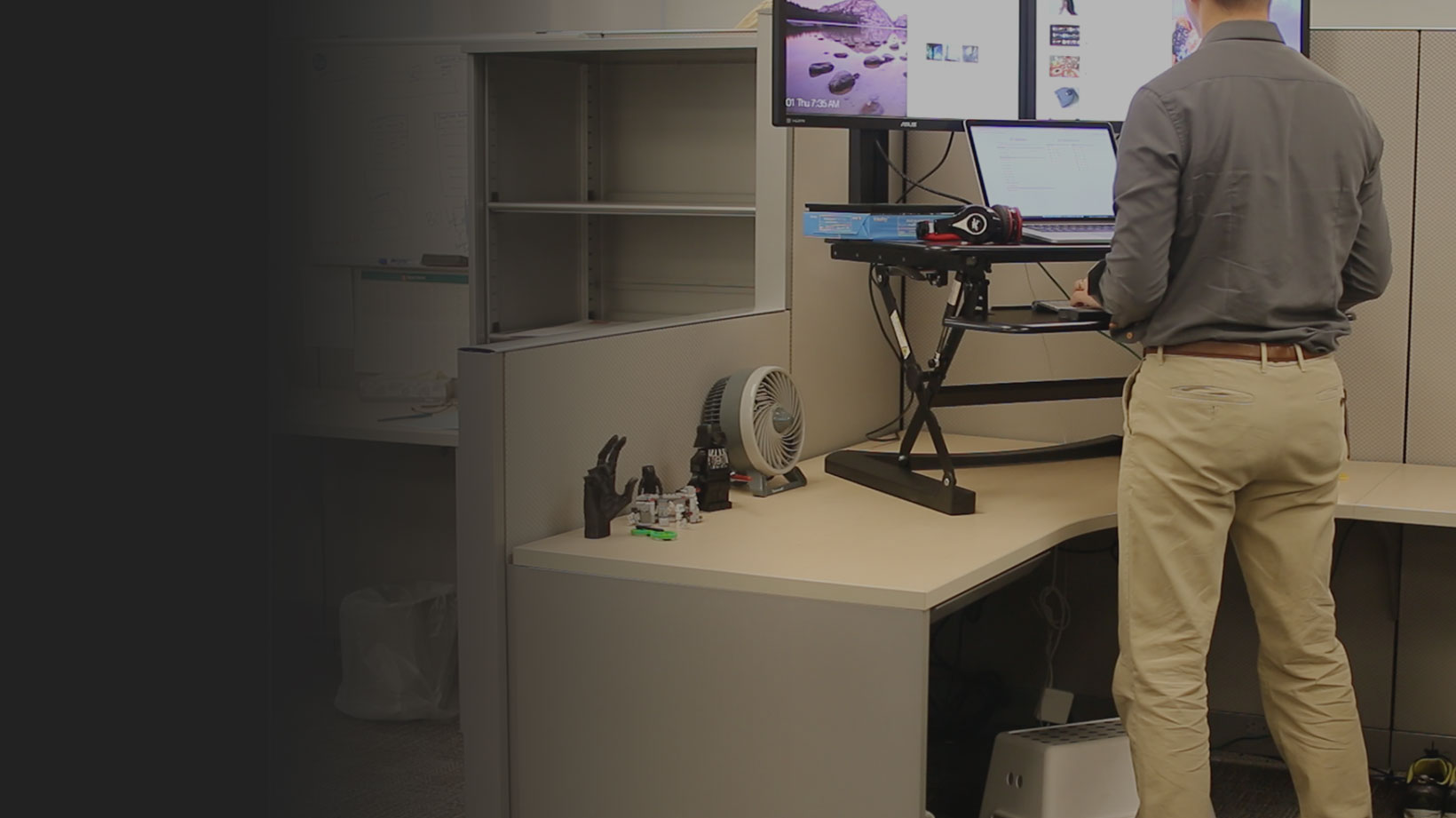The first thing you need to know is that there are three main types of standing desks: the fixed or traditional standing desk, the Riser and the adjustable-height desk.
- The fixed standing desk or rig is any setup that allows a person to stand or be upright while working but doesn’t give them the option to sit down. This is a really common configuration and is the kind of desk that really started the standing revolution. Quick side note, this is actually how I got into standing at work. I made my first standing desk for about $28 from a couple of Ikea end tables and a shelf. I made a video about it several years ago that you can check out here. After a year or two with that setup, I built a coffee table version to have a little more desktop space. This second setup, including the stool, only cost about $60. In addition to the traditional standing desk, this genre also includes some more aggressive desks designed to help you get some light exercise while you work, like treadmill desks and even elliptical desks. Besides full desks, there are also rigs that raise your computer and monitors off the desk but don’t allow for them to be quickly or easily lowered again. The price range for a fixed standing desk or rig starts at Free.99 for a simple DIY setup using books, boxes, crates or anything else you can get your hands on, and might cost as much as a few hundred dollars for a higher end DIY standing desk. On the commercially available side, traditional standing desks start at around $150 but are generally in the $250-500 price range.
- Next up is Risers. Risers are an addition to your existing desk that give you the option to quickly go from sitting to standing or vice versa. They come in a wide range of sizes, materials and options and are harder to make yourself but not impossible. In 2012 I set out to make my own desktop extender that I could lift up and down at will. I came up with this one and used it for several years but it required two people to lower it, so it wasn’t very effective. Fortunately, there are many commercially available options. As far as price, a DIY version of this type of desk is likely going to set you back at least $50 in supplies and parts while commercial options for these risers typically range from $200-$500. If you just need to lift a laptop, not a larger area, you can pay as little as $40.
- Last up is the adjustable-height desk. Much like Risers, these can quickly go from sitting to standing height but these are desks where the entire surface of the desk moves up and down, either electronically or manually. This is a great option if you either don’t have or want to replace an existing desk and want the added advantage of having a nice, large surface that moves up and down with you. Adjustable height desks, like risers, can be complex to build on your own and would likely cost $50-100 on the low end for a DIY version. The commercially available options start as low as $250 (even for an electronic, motorized version) and can cost as much as several thousands dollars.
Sitting vs Standing
Tons of research has been done on the effects of sitting vs standing. I’ve read dozens of articles on the subject and one of the best resources I’ve found on the impacts of sitting vs standing at work is a study from Cornell University on ergonomics. The study concludes the following:
- You shouldn’t sit all day. Sitting for more than one hour at a time leads to fat build-up and is related to heart disease risks. Sitting for 8-10 hours/day for years on end is extremely unhealthy.
- You shouldn’t stand all day. Extensive standing increases the risk of varicose veins and is harder on the circulatory system, particularly for the legs and feet. It fatigues us about 20% more than sitting (for me it feels more like 40%). Also, it decreases our fine motor skill abilities, which, depending on your occupation, could be problematic.
- Sit/Stand Desks aren’t an easy fix. People with sit/stand desks tend to spend most of their time sitting within about a month of getting their desks. Also, when people do stand, it tends to be for only 15 minutes or so.
- So what do they recommend? The pattern I’m about to introduce you to changed my sitting and standing behaviors at work for good because not only does it make perfect sense but it’s also very reasonable to accomplish. Here’s their advice: “Sit to do computer work. Sit using a height-adjustable, downward titling keyboard tray for the best work posture, then every 20 minutes stand for 8 minutes AND MOVE for 2 minutes.” That, my friends, is the key. Get into a habit of standing and then walking every half hour. The movement only needs to be a couple of minutes and the standing only for eight. That’s extremely doable and a sit/stand desk or riser makes this possible. Check the description or my article for links to apps that help you keep track of time intervals for this method.
Posture
Posture while standing is as important as standing itself. Here are a few tips to keep in mind while you’re standing.
- Your elbows should be at a 90° angle while you type. Your monitors should be within arms reach and should be at a height where you can see them easily without looking up, and they should be slightly below eye level.
- Alternate positions. It’s important to change your posture while you stand. Lean on different feet… don’t lean at all… put one leg up… switch legs. Keep changing to keep moving.
- Avoid leaning over on your desk or doing anything that would be stressful on your back or neck.
Mats are Critical
Buy a decent mat or two for work and it’ll make standing way easier. Costco sells a $20 mat that is actually pretty decent and is one of the more affordable options out there. Nicer Anti-fatigue mats are upwards of $100 but if you stand a lot, they’re worth it. Try doubling up and using two or more mats. You don’t want to be standing in a foam pit, but you definitely don’t want to be standing on a concrete floor either.
Footwear Matters
Wear comfortable shoes if you can. Choose shoes that are supportive and that won’t bother you after several intervals of standing. If wearing comfortable shoes isn’t an option, don’t wear shoes while standing. When combined with a good mat, being barefoot is really quite comfortable.
Use a tool or app to help you keep track
There are apps for desktops that help you keep track but all of the ones that I’ve tried are very manual and I found that I lost interest in using them. There are watch apps if you use a smart watch and this can be a great way to keep track. Personally I use a phone app that reminds me every twenty minutes and then again after ten minutes. None of these options seems like the perfect solution, however. I think a sensor driven device would be ideal – maybe one that would keep track of the time that I’m at my desk and if it’s raised or lowered. Better yet, a way to keep track of when I’m sitting, standing or moving throughout the entire work day. If you know of such a thing, please leave a comment and I’ll update the description.
So that’s standing desks in a nutshell. They’re a great way to be more active at work and to reduce the time you spend sitting. Of course, standing and sitting are only one part of being healthy during the work day. There’s a lot of great info out there about staying active in your office, like these 10 Office Workouts You Can Do To Boost Your Productivity, for example. Do you have any tips about standing desks or standing at work that you’d like to share? Help us all out by leaving a comment below!


Hey Nils, Where are the links to all desks seen in the video?,
Make it easy to time standing, sitting, and moving with this free timer for Windows PCs: https://chris.dziemborowicz.com/apps/hourglass/